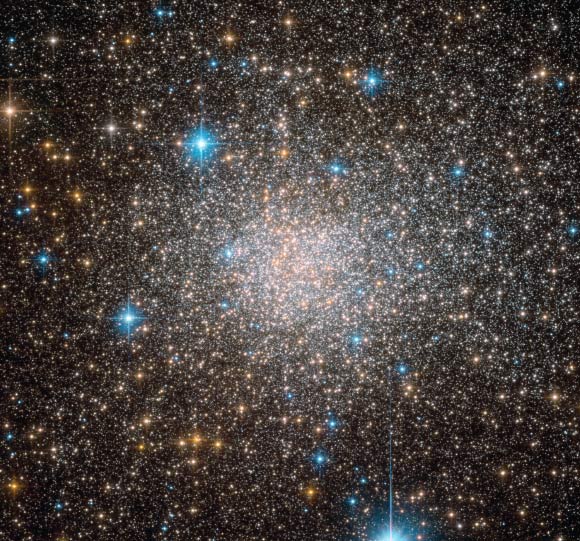Using data from the MeerKAT radio telescope and NSF’s Green Bank Telescope, astronomers have discovered ten new millisecond plusars in the globular cluster Terzan 5.

This Hubble Space Telescope image shows the star cluster Terzan 5. Image credit: F. Ferraro / NASA / ESA / ESO.
The stellar cluster Terzan 5 is a crowded home for hundreds of thousands of different types of stars.
Also known as ESO 520-27 and 2MASX J17480455-2446441, it is located approximately 19,000 light-years away in the constellation of Sagittarius.
“Terzan 5 has historically been one of the most widely studied globular clusters and has yielded remarkable results across multiple wavelengths,” said National Radio Astronomy Observatory astronomer Scott Ransom and his colleagues.
“Located in the inner bulge of the Milky Way, it is believed to be a remnant of primordial structures that are integral to Galaxy formation.”
“Terzan 5 is massive (1.09 million solar masses) and is among the globular clusters with the highest stellar encounter rate.”
“This is commensurate with Terzan 5 holding the record for hosting the largest number of confirmed millisecond plusars in a globular cluster (39 prior to this work) of which more than 50% are in binary systems (20 prior to the work).”
The ten new plusars were discovered as part of the Transients and Pulsars with MeerKAT (TRAPUM) Large Survey Project.
“It’s very unusual to find exotic new pulsars,” Dr. Ransom said.
“But what’s really exciting is the wide variety of such weirdos in a single cluster.”
Using data from the Meerkat telescope, the authors were able to determine the rough location of each pulsar by tracking and timing how quickly they rotate.
The archival data from the Green Bank Telescope revealed the bizarre and eccentric details of these stars.
“Without the Green Bank Telescope’s archive, we wouldn’t have been able to characterize these pulsars and understand their astrophysics,” Dr. Ransom said.
“The data allowed us to pinpoint the pulsars’ position on the sky, measure their specific movements, and see how their orbits changed over time.”
Among the discoveries, the astronomers saw two likely neutron stars pulled into each other’s orbit as a binary system.
Out of 3,600 known pulsars in the Galaxy, only 20 have been identified as double neutron-star binaries.
When pulsars pair off in binaries, the gravitational pull from one to the other can steal material and energy, causing one to spin even faster, becoming a millisecond pulsar.
This pair could be a record breaker, with a new contender for fastest spinning pulsar in a double neutron-star system, and the longest orbit of its kind.
The current record holder for fastest spinning pulsar already resides in Terzan 5.
The researchers also observed three new rare pulsar ‘spider’ binary systems (in addition to five already known in the cluster).
“The discovery of these strange pulsars allows us to better understand globular clusters, neutron stars, and even test Einstein’s theory of general relativity, along with expanding what is known about pulsar categories,” they said.
Their work appears in the journal Astronomy & Astrophysics.
_____
P.V. Padmanabh et al. 2024. Discovery and timing of ten new millisecond pulsars in the globular cluster Terzan 5. A&A 686, A166; doi: 10.1051/0004-6361/202449303
